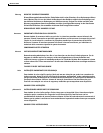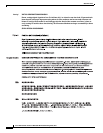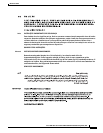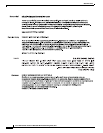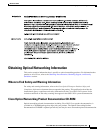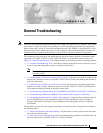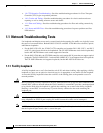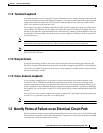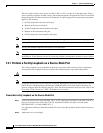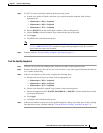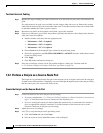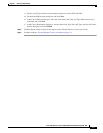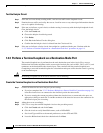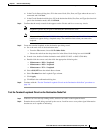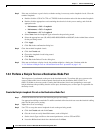
1-3
Cisco ONS 15310-CL and Cisco ONS 15310-MA Troubleshooting Guide, R7.0
Chapter 1 General Troubleshooting
1.1.2 Terminal Loopback
1.1.2 Terminal Loopback
A terminal loopback tests a circuit path as it passes through the cross-connect pathways of the node and
loops back from the port where the loopback originates. A terminal loopback on an OC-N port turns the
signal around before it reaches the LIU and sends it back through the card. This test verifies that the
card’s cross-connect circuit paths are valid.
For example, if you place a terminal loopback on a ONS 15310-CL optical port, the test-set traffic enters
on the 15310-CL-CTX DS-3 port and travels toward the OC-N port. The terminal loopback placed on
this OC-N port turns the signal around before it reaches the LIU, sending it back through the card to the
electrical port. This test verifies that the optical cross-connect paths are valid (but it does not test the LIU
for the OC-N port).
Note In CTC, the terminal loopback is sometimes called a “terminal (inward)” loopback, indicating the
direction that the loopback signal travels—that is, back toward the port where it originated.
Note Due to hardware limitations on a terminal loopback, you cannot send an AIS downstream on a Cisco
ONS 15310-CL CTX card.
1.1.3 Hairpin Circuit
A hairpin circuit brings traffic in and out on an electrical port instead of sending the traffic onto the
OC-N line. A hairpin loops back only one specific synchronous transport signal (STS) or virtual tributary
(VT) circuit. This kind of circuit test can be run on a node running live traffic because it does not affect
the rest of the facility’s traffic.
1.1.4 Cross-Connect Loopback
A cross-connect loopback tests a circuit path as it passes through the cross-connect portion of the
15310-CL-CTX or CTX2500 and loops back to the port being tested. Testing and verifying circuit
integrity often involves taking down the whole line; however, a cross-connect loopback allows you to
create a loopback on any embedded channel at supported payloads at the STS-1 granularity and higher.
For example, you can loop back a single STS-1 on an optical facility without interrupting the other STS
circuits.
You can create a cross-connect loopback on working or protect OC-3 optical ports unless the protect port
is used in a 1+1 protection group and is in working mode.
Note If a terminal or facility loopback exists on an optical port, you cannot use the cross-connect loopback.
1.2 Identify Points of Failure on an Electrical Circuit Path
Facility loopbacks, hairpin circuits, and terminal loopbacks are often used to test a circuit path through
the network or to logically isolate a fault. Performing a loopback test at each point along the circuit path
systematically isolates possible points of failure.



